Learning how to grow okra from seeds can ensure you get all the nutritional and culinary benefits from this tasty fruit with little to no slime.
Thankfully, okra is very easy to grow, so long as you provide them with enough light, nutrients and moisture. Plus, you also have to remember to harvest the fruit at the right time.
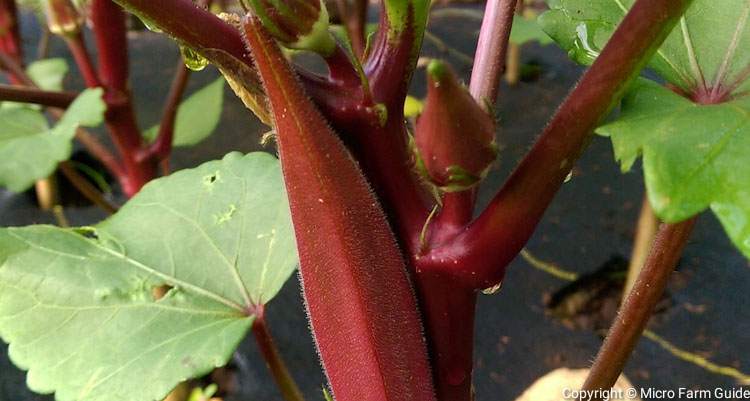
In this article, I will share the simple process we use to grow okra in our garden and some tips to get lots of pods throughout the growing season. Let’s get started!
1. Choose A Sunny Location
Okra is a warm-season plant that requires at least 6 hours of direct sunlight daily. As a result, you should choose a well-lit location in your garden.
Ideally, this area should be well-ventilated and free from enormous obstacles that can cast shade during the planting season.
Ensure that there is enough space between plants to allow light and air to flow freely, and prune plants when necessary.
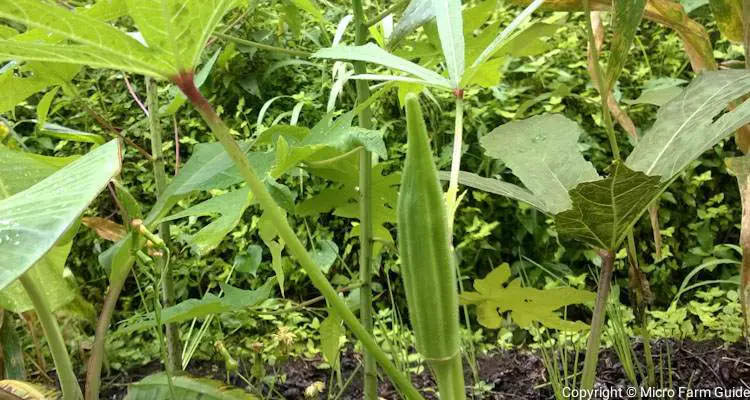
2. Prepare Soil For Planting
Okra is a heavy feeder and grows best in fertile, well-drained, moist soil. As a result, you should add plenty of organic material to the soil to provide suitable growing conditions.
I do not dwell on exact compositions. Yet, okra plants thrive in our garden’s clayey-loam soil, with some added compost mulch.
Some people have indicated that okra performs poorly when grown in pure compost. I cannot confirm this since the roots of my potted plants usually grow through the pot and into the soil.
3. Sow Seeds Directly In Ground Or Seedling Trays
You can sow okra seeds directly into the ground provided the soil temperature is at least 65°F.
Plant 2 to 3 okra seeds ¼ inch deep into the soil, spacing them at least 12 inches apart, then water thoroughly.
You can sow okra seeds indoors, using large seedling trays, to avoid damaging the roots when transplanting.
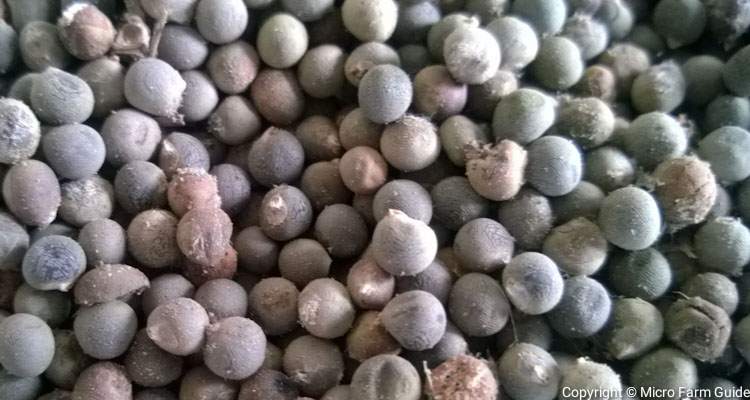
It is advised to soak okra seeds overnight. This supposedly encourages them to sprout faster.
However, I have not done this before since I use “fresh okra seeds” and live in the tropics, where they germinate quickly.
4. Transplant Seedlings (Optional)
Okra seedlings are ready to transplant within 14 days after sowing. Their roots will become root-bound or risk being damaged if you wait too long.
Transplant okra seedlings into the soil, spacing them at least 12 inches between plants.
If you plant okra too close together, they will spread and cover smaller plants, stunting their growth and increasing the risk of pests and fungal disease.
Ensure you plant one seedling per hole, removing the weaker plants if more than one germinated per seedling cell.
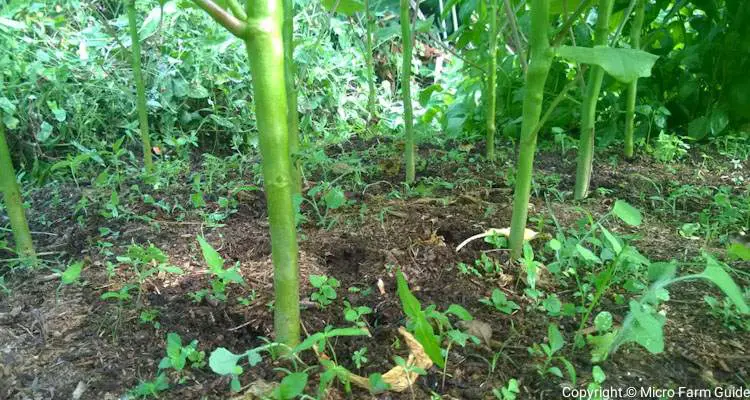
5. Water Plants To Keep Soil Moist
Okra plants require 1 to 2 inches of water per week depending on the weather. Still, they can withstand dry spells at risk of producing tougher pods.
Keep the soil moist but not soggy. Remember, the roots of the okra plant can reach up to 4 feet deep, so don’t worry too much if the soil’s surface dries, so long as the soil is moist.
That said, you can also apply a surface dressing of compost as a mulch. This layer helps to retain water while providing the plants with much-needed nutrients.
6. Fertilize Okra Plants When Needed
Okra plants grow fast and require a lot of nutrients. Apply a balanced fertilizer to the growing area while preparing the soil, then every 3 to 4 weeks afterward.
Ideally, you should use a solid organic fertilizer rich in nitrogen. Yet, materials such as compost can also be added to the soil to provide the necessary conditions for microorganisms to function.
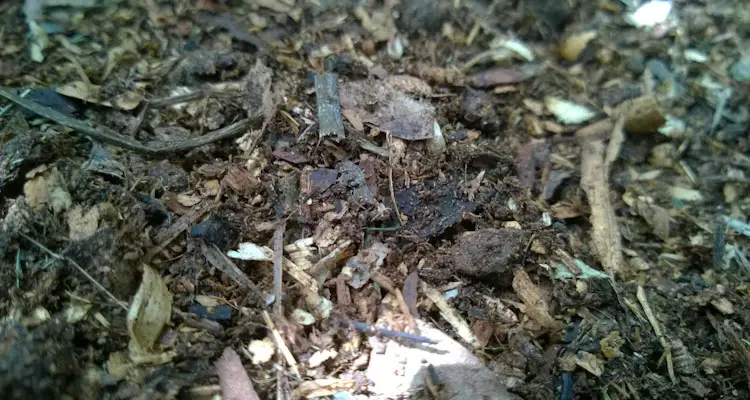
7. Remove Older Leaves And Monitor For Pests
You can start pruning as soon as the plant produces at least 8 leaves. Remove older, deformed, and yellowing okra leaves.
Keep at least the top 4 okra leaves to assist with photosynthesis. I also like to cut leaves away as I harvest the pods.
Inspect the plant for signs of disease and infections. Keep an eye out for Aphids, Stink Bugs, and powdery mildew.
Curly leaves or black and white clusters are tell-tale signs of pest damage and should be removed from the plant and thrown away from the garden altogether.
This initial pruning “opens up” the plant and allows air and sunlight to enter a move throughout the area.
8. Harvest Okra When Young And Tender
Okra plants can grow year-round in tropical climates and produce over 30 pods per plant, depending on variety and growing conditions.
Harvest okra pods when young and tender, preferably about finger length. At this point, they are usually crispy with little to no slime. You can also pick young leaves for cooking.
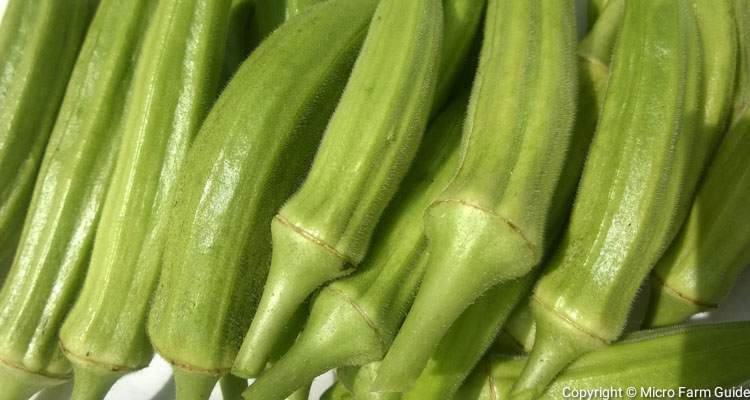
Okra pods should snap off the stem easily. Pick the young pods frequently to encourage the plant to produce more pods and grow.
Okra can grow all year round in tropical regions. Still, you must monitor the plant and pick the pod about every other day, when they are about finger length.
Your plant will continue to bear fruit if it has suitable growing conditions and is harvested while the pods are still immature.
Okra plants can produce up to 30 pods per plant, depending on the variety, temperature, frequency of harvesting, and so on.
9. Prune Okra Plants To Encourage Second Crop (Optional)
Cut the main stem of the okra plant once it reaches too high for you to pick by hand. This will encourage the plant to create side shoots, which will, in turn, produce additional pods.
In most cases, the okra will regrow after it is cut. However, if you see holes or soft spots, you will have to either cut lower down the stem or remove it altogether.
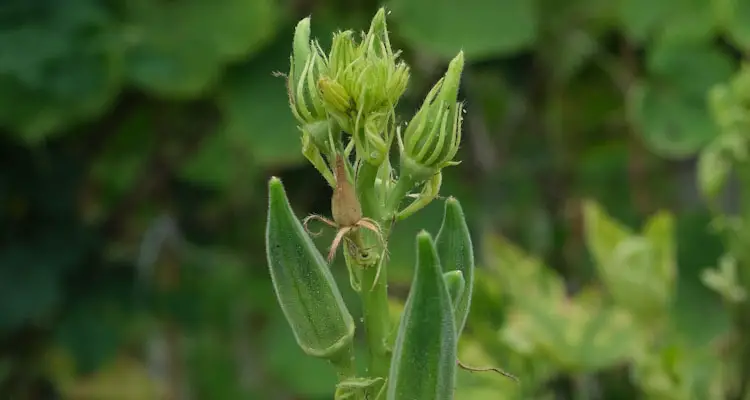
I’ve noticed that these side shoots also grow as I prune the leaves from the plant. This makes the decision to “top” the plant even easier.
Related Questions
Is okra easy to grow?
Yes, Okra is easy to grow from seed, provided they receive suitable temperature, sunlight, moisture, and nutrients. They are not too picky about soil, which makes them perfect for less-than-ideal growing media.
What is the best month to plant okra?
The best months to plant okra are around April in the Northern Hemisphere and November in the Southern hemisphere, when temperatures are expected to be above 65°F.
Can I plant two okra plants together?
You can plant two okra plants together but space them at least 12 inches apart to avoid competition for light and nutrients.
How long does it take to grow okra from seed?
Okra plants take between 49 and 70 days to grow from seed to harvest, depending on the variety and the growing conditions.
